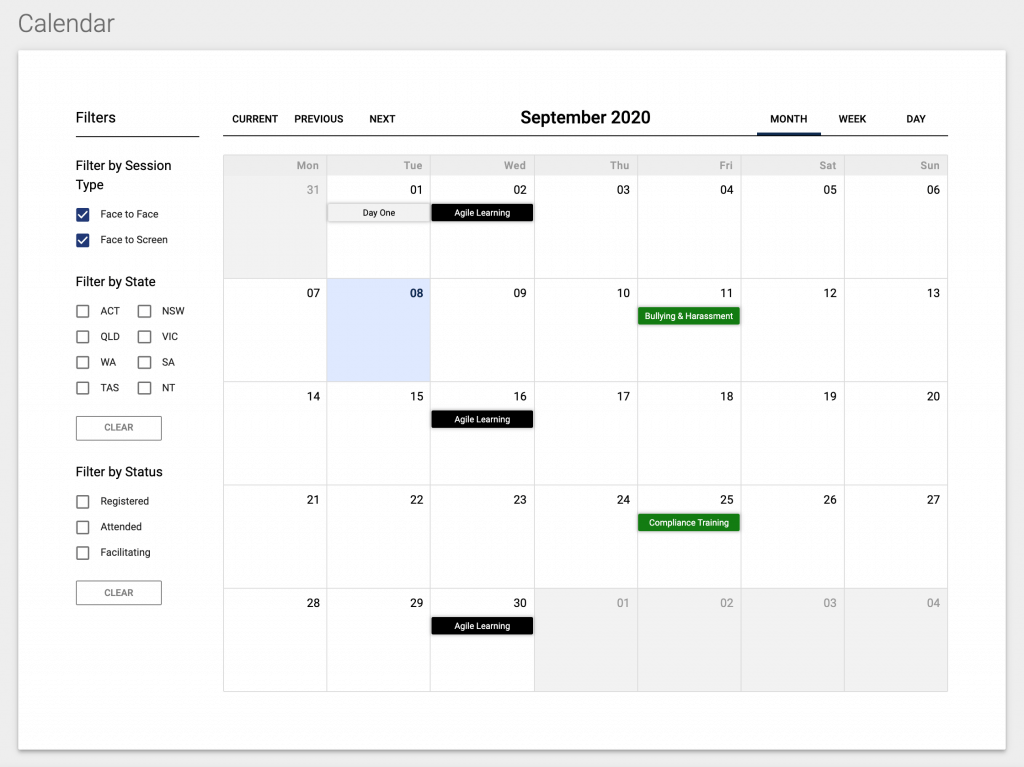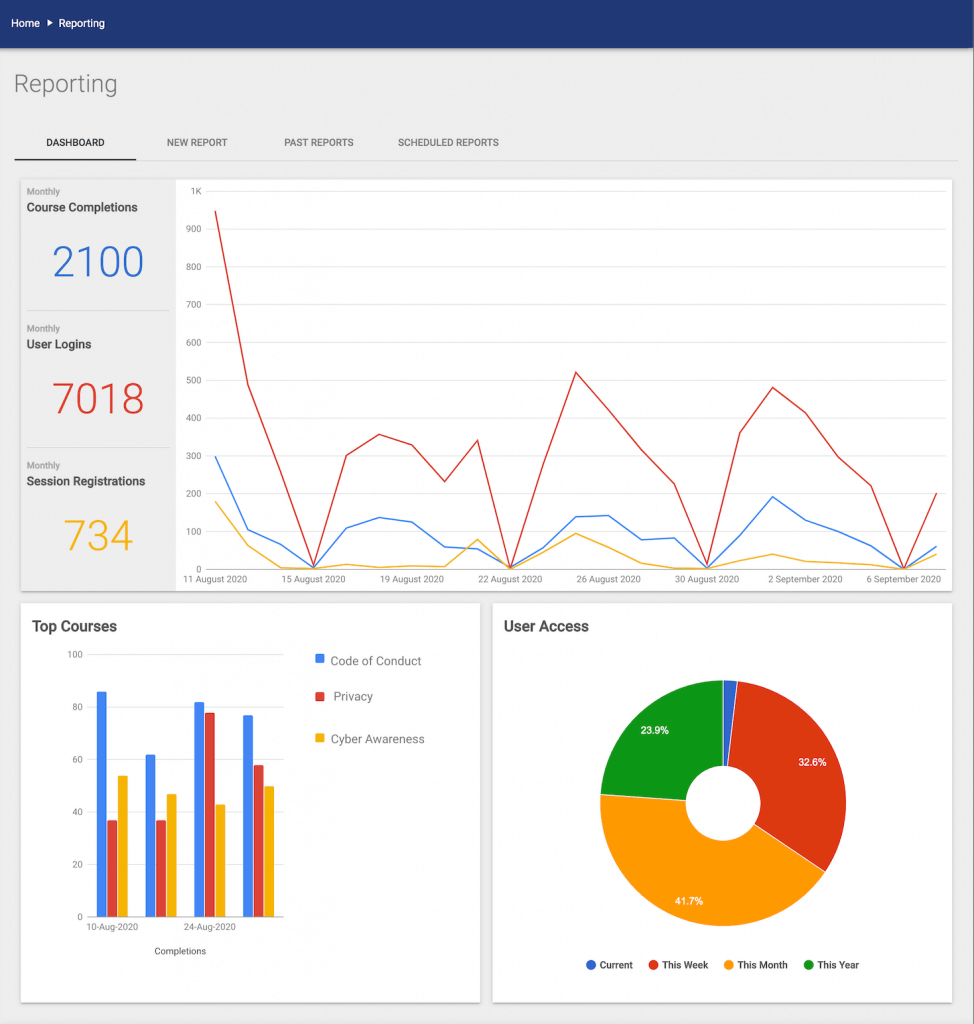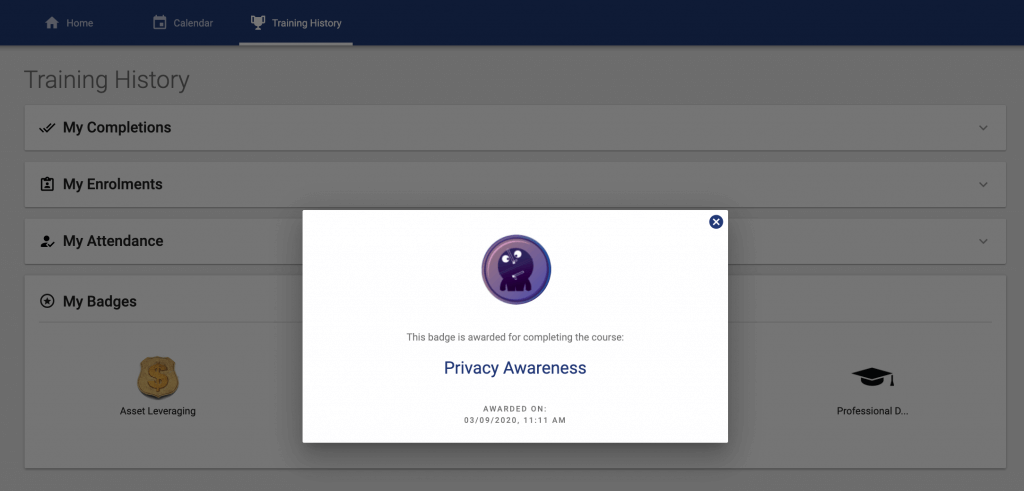Increasing Employee Engagement with an LMS

70% of employees aren’t engaged at work. The right LMS can get that number down quickly.
It’s all too easy to disengage from work these days. You can scroll Instagram. Gossip with your team. Scroll Instagram to avoid hearing your team gossip. Watch the clock until 5pm on the dot, when you’re straight out the door.
Day-to-day, engagement can fluctuate. Long-term, you need to offer a value proposition that keeps employees invested in the big picture. That proposition is career development, and the easiest way to facilitate that is with a learning management system.
We’ll discuss just why an LMS is exactly what you need to improve employee engagement in this article, as well as give you a few employee engagement ideas to try out.
What is employee engagement?
Before we dive too deep, let’s start with a definition of what we’re trying to achieve.
Employee engagement is a measure of the relationship between employee and organisation—generally seen through the level of motivation and commitment the employee displays in the workplace.
The cost of low employee engagement
Disengaged employees were around long before a certain pandemic. In fact, disengaged employees can find just about any reason not to engage with their work: They’re not given enough responsibility. They’re given too much responsibility. They have no possibility for career growth. Their boss is another b-word. They might even just hate the layout of the office. Perhaps they slept bad last night—there’ll always be an excuse.
But when employees check out, employers feel the heat. Gallup found global employee disengagement costs $7.8 trillion in lost productivity. Yes, trillion.
And the problem, like many of those aforementioned excuses, is often found in the experience offered by the organisation, managers and team members. A poor employee experience generally manifests in:
- High and expensive turnover rates, costing up to 33% of an employee’s salary.
- Toxic culture that shelters disengaged employees while shunning and even driving out top talent (into the arms of your competitors).
- Inconsistent quality of products or services, as a direct result of immature workforce capability driven by turnover.
And it shows that those custodians of the employee experience—HR, organisational development, L&D, leadership and management—are ineffective and running a cost centre through the workforce.
On the other hand, engaged employees can increase sales by 37% and are 31% more productive. 78% of engaged staff are brand advocates. They take 2.7 sick days per year, compared to the 6.2 that disengaged folks take. And 54% of disengaged employees say their work lives negatively impact their physical health, compared to just 12% of the engaged.
So, the issue at hand is not necessarily how to go about improving employee engagement. It’s about understanding the root causes, and the best solutions for those problems. Which brings us to the LMS.
How to use your LMS to increase employee engagement
Gen Z and millennials currently make up about one third of the global workforce. They grew up in a largely digital world. (Only the oldest of millennials will remember handwriting school assignments.) They are disproportionately impacted by stress in the workplace, which is why they prioritise flexibility and growth in their careers.
On average, employees stay in a role for just four and a half years, and skills reach their half-life by five. When you consider careers have a lifespan of at least ten times longer, lifelong learning becomes vital.
This state of the working world leaves you with one question to address when it comes to reducing employee turnover: “What’s in it for me?”
Simply put, the answer is most often, “More personalised training and development.” How that looks with a learning management system is a little more detailed.
Microlearning
Consider this less about creating bite-sized chunks of learning, and more about enabling employees to learn in the moment of need.
The LMS has long been a decentralised part of employee training, with L&D pros curating massive content libraries, analysing reporting data and designing learning experiences as transactions for business leaders. When the delivery and process for learning is seen as an afterthought for leaders, it’s not exactly going to encourage employees to access extraneous training. Especially when you consider that one employee will spend 20% of their workweek looking for internal information. Why add more time sink into their week?
And when it comes to how engaged employees perform, the benefits of this mode of learning include:
- Demonstrating knowledge of employee pain points by anticipating their capability needs
- Augmenting everyday performance with actionable insight
- Accelerating learning transfer by placing critical information in the flow of work.
Microlearning modules are also easier to develop, update and distribute compared to long and tedious courses. Shorter courses focus on key topics, making the learning process more efficient and effective. It’s also a natural fit for mobile-based learning as it’s easily managed and digested while providing a familiar experience for users.
Guided learning
Any LMS worth its salt should give you the option to write, edit and easily format your course content. As much as you can create a plethora of content relevant to your organisation’s processes, sometimes the best resources are mined from further afield. Consider what you need to create in-house (like certifications) and what should come from third-party content providers (industry compliance training, for example).
Take that little bit of extra time to research and craft your content, so that you have a fully stocked catalogue of resources like so:

Don’t swing too hard in the direction of creating massive content libraries just for the sake of covering all content bases. The problem we often see is giving learners too much choice, which can mean they:
- Don’t have time to sort through all said content, and consequently, just don’t.
- Don’t know where to start, or they pick topics that aren’t impactful or applicable post-training.
- Miss out on feedback without being on a formal development plan (and employees crave feedback on all performance fronts).
All of which means you’ll likely get net zero ROI on training, making it hard to justify investing all that training in the first place. Instead (and piggy-backing on from microlearning) of self-directed learning, take a self-guided approach. It’s better for everyone, given:
- L&D or organisational development start by uncovering capability gaps at the employee level
- Everything within the training lifecycle (content, assessments, program durations, etc.) can be appropriately tailored to individual capability gaps
- Learners can then access training that is relevant to them, but at their own pace.
It’s important for employees as the practice itself teaches them to better understand the purpose of training. Enable employees to manage the minutia of learning—like when and where they want to do it—through, say, a filterable calendar. Look for one that can filter by lesson, status and time frame for ultimate oversight.

Data-driven insights
Your LMS will record snippets of data, such as a user’s score on a test, how quickly they are progressing through a module, the number of times they have logged in to the system and if they are interacting with other users. Through learning analytics, admins can also see how users are performing and predict if they will need help to complete a module.

You want data that’s going to help boost employee engagement in L&D, not just tell you who completed what. So look out for:
- A variety of LMS reports, such as capability assessment, development plan, and expression of interest reports
- Functionality that helps you analyse the efficacy of learning interventions through performance outcomes
- Real-time reporting to compare trends, spot patterns and measure progress to business outcomes.
This data allows you to derive actionable insights for improving your courses, putting you one step closer to affecting success beyond L&D—in employee performance, time to proficiency, organisational capability, and ultimately company culture.
Gamification
People love playing games so much, they’ll create them to win (or play with) anything—which is where gamification comes in.
Many LMS platforms incorporate game-like incentives and principles, such as badges, level progression and points systems, to make ongoing learning especially more engaging. Not only does gamification improve the user experience, knowledge retention, and information sharing, but it turns repetitive or dry modules into quite literally rewarding and engaging competitions.

Another reason gamification helps keep employees engaged is that the gratification is short term or even instant. Goals don’t feel far away for learners, but they can still see tangible progression by collecting badges, as an example.
Multimedia
Aside from being naturally more engaging than black text on a white page, multimedia helps to simplify complex ideas. Training design is a core factor in learning transfer. Ergo, ignore training design theory, and you’re practically guaranteeing poor engagement.
The point is to vary how information is delivered, especially if you’re repeating or reinforcing it. Instead of pre-recorded videos, get your subject matter experts to host live learning seminars. Follow it up with a multiple choice quiz and have suggested courses available at the end (thereby creating a channel through which to push more training).

Multimedia also makes your content more accessible to those with disabilities. Think about subtitles on videos, image descriptions, pre-recorded transcripts for blocks of text, and written transcripts for video and audio files, as well as even correct colour contrast. The devil is often in the technical detail.
Collaboration
Look, most learning transfer happens when people can share and reinforce knowledge with peers and within context. It’s also more likely to happen after the training fact, meaning that you need to provide shareable evergreen content.
Ergo, utilise your learning management system to its full potential. Remember microlearning? Make it a central knowledge management system, so rather than being just a place for development plans, it holds the answers to almost any question an employee may face in the workplace. For example: Two- to three-minute long video demonstrations of internal software tools or successful sales pitches, or notice boards for crowd-sourced problem solving.
Making the LMS the heart of intellectual capital further facilitates a central location for all HR and company updates and training programs, making things more convenient and the employee experience smoother for individual staff. Think about it: Training outcomes are directly linked to performance outcomes, which are in turn tied into career development managed by HR.
Key takeaways
What makes employee engagement important is how much it impacts your bottom line. You see, an engaged workforce is more likely to improve employee retention, time to productivity and revenue down the line.
But you need to have the right tools and mechanisms in place to truly engage employees. So, in the name of increasing employee engagement, look to your learning management system for:
- Tailored professional development opportunities
- On-demand microlearning that addresses everyday problems
- Real-time reporting analytics on strategic performance outcomes
- Guided learning aimed at business success but geared towards individual needs
- Features that encourage positive associations with L&D, like gamification
- Informed learning design and delivery
- Centralised and crowd-sourced business knowledge.